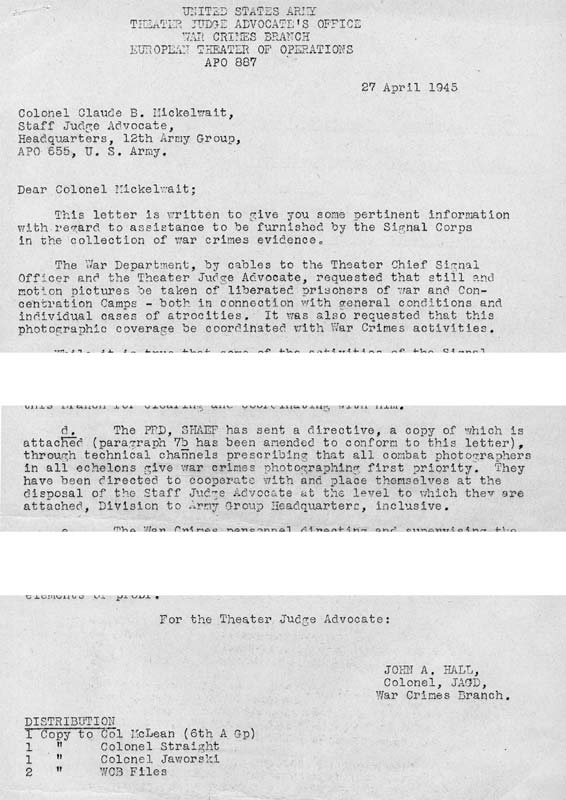"Making it public"
 Excerpt of the orders given by the Judge Advocate European Theatre of Operations regarding the deployment of Signal Corps teams in liberated concentration camps to collect evidence of war crimes. A directive, dated April 1945, of the commander-in-chief of the Supreme Headquarters of allied Expeditionary Forces (SHAEF), Gen. Dwight D. Eisenhower, is mentioned here, by which in war news coverage he gives official priority to photographic documentation of the war crimes committed in the concentration camps.“ (NARA, College Park)„… all combat photographers in all echelons give war crimes photographing first priority.”
Excerpt of the orders given by the Judge Advocate European Theatre of Operations regarding the deployment of Signal Corps teams in liberated concentration camps to collect evidence of war crimes. A directive, dated April 1945, of the commander-in-chief of the Supreme Headquarters of allied Expeditionary Forces (SHAEF), Gen. Dwight D. Eisenhower, is mentioned here, by which in war news coverage he gives official priority to photographic documentation of the war crimes committed in the concentration camps.“ (NARA, College Park)„… all combat photographers in all echelons give war crimes photographing first priority.”
After the liberation, irrefutable facts regarding the conditions in the concentration camp Gusen for the first time became known to a wider audience and there could no longer be any doubt as to the extent of the crimes committed at this site.
Even during the closing stages of the war, but in particular after the capitulation of Germany, Allied policy was designed to ensure the greatest possible dissemination of information regarding the atrocities of the Nazi regime. Such documentary efforts were pursued on many different levels and were in equal measure directed at a global public and at the people of Austria and Germany.
In view of the extent of the committed atrocities the legal prosecution of perpetrators, including the collection of evidence and trial before an Allied military court were of prime importance. In line with a policy of reeducation, the underlying intention was to demonstrate to Germans the consequences of their active or passive support for the political regime and to instill in them an awareness of Germany’s war guilt through the presentation of irrefutable facts. Finally, the people of the Allied nations, too, needed to be informed about the atrocities, not least to convince doubters of this war’s necessity, even after the fact.
Excerpt of the orders given by the Judge Advocate European Theatre of Operations regarding the deployment of Signal Corps teams in liberated concentration camps to collect evidence of war crimes. A directive, dated April 1945, of the commander-in-chief of the Supreme Headquarters of allied Expeditionary Forces (SHAEF), Gen. Dwight D. Eisenhower, is mentioned here, by which in war news coverage he gives official priority to photographic documentation of the war crimes committed in the concentration camps.“
(NARA, College Park)